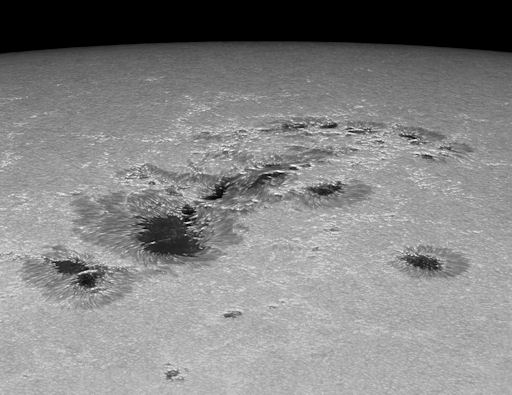AURORAS OVER THE SOUTH POLE: On July 10th, observers are reporting butterfly-shaped auroras directly over the South Pole. The shape of the southern auroral oval often leaves the South Pole in a "doughnut hole" of poor visibility, but today is an exception. [aurora gallery]
NORTHERN LIGHTS: For the second day in a row, Earth's polar magnetic field is unsettled and glowing with auroras. Paul Zizka sends this picture from Banff National Park in Alberta, Canada:
"Yet another sleepless night at Lake Minnewanka--and it was worth it," says Zizka. "The aurora danced on and off for hours. Most of the time it was barely visible to the naked eye, but now and then Mother Nature would put on a show that was hard to miss. The displays ranged from a very interesting, long-lasting pink streak directly overhead to wild green curls and purple pillars to the north and east."
The source of the display was not an explosion on the sun, but rather a fluctuation in the interplanetary magnetic field (IMF). On July 9th, the IMF near Earth tipped south, opening a crack in our planet's magnetosphere. Solar wind poured in and ignited the lights.
Solar wind conditions remain favorable for high-latitude auroras on July 10th. NOAA forecasters estimate a 25% chance of polar geomagnetic storms. Aurora alerts: text, voice.
BIG SUNSPOT: One of the biggest sunspots in years, AR1520, is turning toward Earth. Christian Viladrich of Nattages, France, photographed the behemoth on July 7th:
"It looks like an expanse of land on the sun," says Viladrich.
Despite the resemblance to land, however, the vast dark cores of sunspot AR1520 are not solid. They are made of magnetism. Each one is a magnetic island nearly as wide as Earth floating in a sea of solar plasma.
The magnetic field of this enormous sunspot is tangled, and harbors energy for strong solar flares. NOAA forecasters estimate an 80% chance of M-flares and a 25% chance of X-flares during the next 24 hours. Solar flare alerts: text, voice.

![]()
Solar wind
speed: 500.1 km/sec
density: 0.3 protons/cm3
explanation | more data
Updated: Today at 1510 UT
![]()
X-ray Solar Flares
6-hr max: C8 1345 UT Jul10
24-hr: M2 0627 UT Jul10
explanation | more data
Updated: Today at: 1500 UT
![]()
![]()
![]()
Daily Sun: 10 Jul 12
![]()
![]()
Sunspot 1520 has a beta-gamma magnetic field that harbors energy for M-class solar flares. Credit: SDO/HMI
![]()
![]()
![]()
Sunspot number: 137
What is the sunspot number?
Updated 09 Jul 2012
Spotless Days
Current Stretch: 0 days
2012 total: 0 days (0%)
2011 total: 2 days (<1%)
2010 total: 51 days (14%)
2009 total: 260 days (71%)
Since 2004: 821 days
Typical Solar Min: 486 days
Updated 09 Jul 2012
The Radio Sun
10.7 cm flux: 178 sfu
explanation | more data
Updated 09 Jul 2012
![]()
![]()
![]()
Current Auroral Oval:
![]()
Switch to: Europe, USA, New Zealand, Antarctica
Credit: NOAA/POES
![]()
![]()
![]()
Planetary K-index
Now: Kp= 3 quiet
24-hr max: Kp= 5 storm
explanation | more data
![]()
Interplanetary Mag. Field
Btotal: 6.9 nT
Bz: 6.8 nT south
explanation | more data
Updated: Today at 1516 UT
![]()
![]()
![]()
Coronal Holes: 09 Jul 12
![]()
![]()
A solar wind stream flowing from the indicated coronal hole cold reach Earth on July 10-11. Credit: SDO/AIA.






